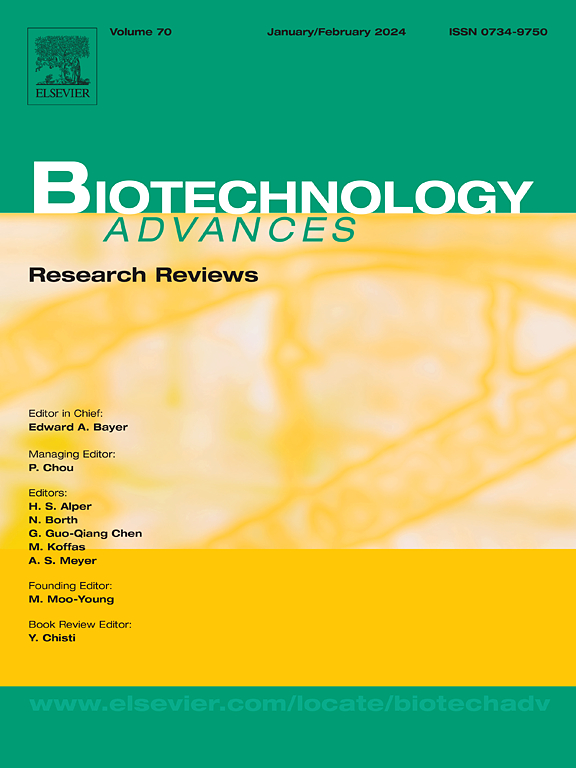Innovations in smart enzyme biosensors: Advancing the detection of antibiotic residues in aquaculture
IF 12.1
1区 工程技术
Q1 BIOTECHNOLOGY & APPLIED MICROBIOLOGY
引用次数: 0
Abstract
In aquaculture, the presence of antibiotic residues is an escalating concern that poses significant risks to human health. Establishing efficient and user-friendly detection methods for antibiotic residues has become crucial to mitigate these potential hazards. To address the limitations of traditional techniques, novel enzyme biosensors, offering high sensitivity and specificity and rapid response, has been introduced for monitoring a wide range of antibiotics in food safety applications. Herein, this paper reviews the innovations and advances of smart enzyme biosensors for the detection of up to 23 antibiotics in aquatic foods (fish, shrimp, crab, etc.) and related water samples in the last decade, focusing on biosensors' construction principles, detection performance, and potential applications. The colorimetric biosensors account for 62.5 %, and the limit of detection (LOD) reaches as low as fM levels. To our best knowledge, this is the first review to introduce the innovations and progress in smart enzyme biosensors for the detection of antibiotic residues in aquaculture, with the evolution from conventional natural enzyme-based biosensors to biosensors containing bio-recognition elements and mimic enzymes, and then the integrated mimic enzyme-based biosensors. These biosensors realized highly-sensitive and specific detection of antibiotics. Further development should focus on exploration of multifunctional and intelligent bio-sensing strategies, robust mimic enzyme-based biosensors, and biosensors based on integrated mechanism of recognition and transduction, so as to promote the techniques from lab studies into practical applications. This review serves as powerful enlightenment to inspire further enhancement of smart enzyme biosensors for monitoring antibiotics in aquaculture to ensure food safety.
智能酶生物传感器的创新:推进水产养殖中抗生素残留的检测。
在水产养殖中,抗生素残留的存在日益引起人们的关注,对人类健康构成重大风险。建立高效且用户友好的抗生素残留检测方法已成为减轻这些潜在危害的关键。为了解决传统技术的局限性,新型酶生物传感器具有高灵敏度、高特异性和快速反应能力,可用于食品安全领域的多种抗生素监测。本文综述了近十年来智能酶生物传感器在水产食品(鱼、虾、蟹等)及相关水样中检测多达23种抗生素的创新与进展,重点介绍了生物传感器的构建原理、检测性能及应用前景。比色生物传感器占62.5 %,检测限(LOD)低至fM水平。从传统的天然酶生物传感器到包含生物识别元件和模拟酶的生物传感器,再到基于模拟酶的集成生物传感器,本文首次综述了用于水产养殖抗生素残留检测的智能酶生物传感器的创新和进展。这些生物传感器实现了对抗生素的高灵敏度和特异性检测。未来的发展重点应放在探索多功能智能生物传感策略、鲁棒模拟酶生物传感器、基于识别和转导一体化机制的生物传感器等方面,从而推动这些技术从实验室研究走向实际应用。本综述为进一步加强智能酶生物传感器在水产养殖抗生素监测中的应用,保障食品安全提供了有力的启示。
本文章由计算机程序翻译,如有差异,请以英文原文为准。
求助全文
约1分钟内获得全文
求助全文
来源期刊

Biotechnology advances
工程技术-生物工程与应用微生物
CiteScore
25.50
自引率
2.50%
发文量
167
审稿时长
37 days
期刊介绍:
Biotechnology Advances is a comprehensive review journal that covers all aspects of the multidisciplinary field of biotechnology. The journal focuses on biotechnology principles and their applications in various industries, agriculture, medicine, environmental concerns, and regulatory issues. It publishes authoritative articles that highlight current developments and future trends in the field of biotechnology. The journal invites submissions of manuscripts that are relevant and appropriate. It targets a wide audience, including scientists, engineers, students, instructors, researchers, practitioners, managers, governments, and other stakeholders in the field. Additionally, special issues are published based on selected presentations from recent relevant conferences in collaboration with the organizations hosting those conferences.
 求助内容:
求助内容: 应助结果提醒方式:
应助结果提醒方式:


